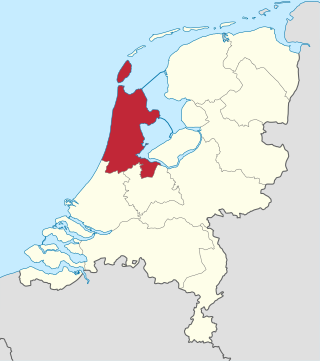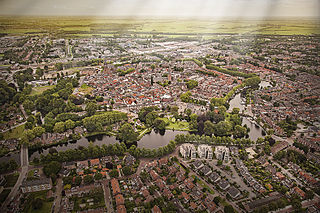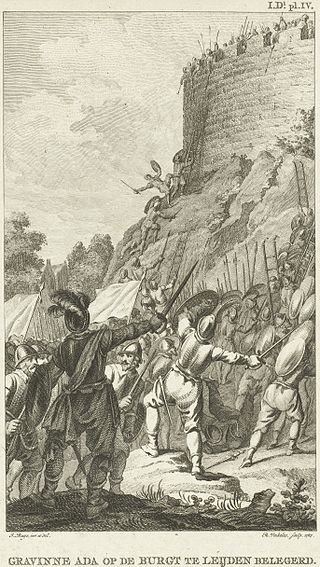
North Holland is a province of the Netherlands in the northwestern part of the country. It is located on the North Sea, north of South Holland and Utrecht, and west of Friesland and Flevoland. As of January 2023, it had a population of about 2,952,000 and a total area of 4,092 km2 (1,580 sq mi), of which 1,429 km2 (552 sq mi) is water.

Woerden is a city and a municipality in central Netherlands. Due to its central location between Amsterdam, Rotterdam, The Hague, and Utrecht, and the fact that it has rail and road connections to those cities, it is a popular town for commuters who work in those cities.

Floris V reigned as Count of Holland and Zeeland from 1256 until 1296. His life was documented in detail in the Rijmkroniek by Melis Stoke, his chronicler. He is credited with a mostly peaceful reign, modernizing administration, policies beneficial to trade, generally acting in the interests of his peasants at the expense of nobility, and reclaiming land from the sea. His dramatic murder, said by some to have been arranged by King Edward I of England and Guy, Count of Flanders, made him a hero in Holland.

The Hook and Cod wars comprise a series of wars and battles in the County of Holland between 1350 and 1490. Most of these wars were fought over who should hold the title of "Count of Holland". The Cod faction generally consisted of the more progressive cities of Holland. The Hook faction consisted for a large part of the conservative noblemen.

The County of Holland was a state of the Holy Roman Empire and from 1433 part of the Burgundian Netherlands, from 1482 part of the Habsburg Netherlands and from 1581 onward the leading province of the Dutch Republic until the Batavian Revolution in 1795. The territory of the County of Holland corresponds roughly with the current provinces of North Holland and South Holland in the Netherlands.
Dirk VI was Count of Holland between 1121 and 1157, at first, during his minority, under the regency of his mother Petronilla. He was the son of Count Floris II. After his death he was succeeded by his eldest son Floris III. He married Sofie of Salm, Countess of Rheineck and Bentheim. She was heiress of Bentheim, which she ruled together with her husband and which was inherited by the couple's second son Otto after his parents' death.

Kennemerland is a coastal region in the northwestern Netherlands, in the province of North Holland. It includes the sand dunes north of the North Sea Canal, as well as the dunes of Zuid-Kennemerland National Park.

The Battle of Zwartewaal was a decisive naval battle during the Hook and Cod wars.

Gijsbrecht IV of Amstel or Gijsbrecht IV van Amstel was a powerful lord in the medieval County of Holland and a member of the Van Aemstel family. His territory was Amstelland, and his son was Jan I of Amstel.

The van Amstel family was an influential dynasty in the medieval Netherlands from the twelfth until the fourteenth century. The family developed the Amstelland and held the stewardship in the ecclesiastical districts in the northwest of the Nedersticht of Utrecht, first in the name of the bishop of Utrecht and later the count of Holland.

The Lords of Brederode were a noble family from Holland who played an important role during the Middle Ages and the Early modern period. The family had a high noble rank and hold the titles Count of Brederode, Count of Gennep, and furthermore they ruled the souverain Lordship of Vianen, the Viscountship of Utrecht among other feudal titles.

John of Nassau was a clergyman from the House of Nassau. From 1267 to 1290 he was Bishop-Elect of the Bishopric of Utrecht as John I. He did not care much for his spiritual functions, and his government also failed due to his weak political and poor financial management. During his reign, the influence of the County of Holland in the Bishopric greatly increased. John's government was one of the worst the Bishopric had to endure; without talent and energy, slavishly surrendering to all sensual pleasures, it was never possible for him to maintain the inner peace, under which the Nedersticht in particular suffered greatly.
Herman VI van Woerden was a lord of Woerden.

The Loon War was a war of succession over the County of Holland from 1203 until 1206, brought on by the death of count Dirk VII. The war was waged between Dirk's brother William of Frisia, and Dirk's daughter Ada who had quickly married count Louis II of Loon.

The name Persijn or Persyn originates from what is said to be one of the oldest and noblest families from Kennemerland. In the 13th century, a branch of the Persijn family concerns the lords of Waterland and Amsterdam. They resided in the lost castle of Huis te Velsen north of Haarlem. Its oldest known ancestor was Dirk Persyn, who was given the title of courtier of the Count of Holland in 1162.
The Battle of Heiloo was a battle during the Friso-Hollandic Wars and the culmination of Count Floris V's first military expedition to West Frisia in 1272. The battle is described in Melis Stoke's Rijmkroniek van Holland and the chronicle of Johannes de Beke. Although the battle was won by Floris' forces, his goal of conquering West Frisia had not been achieved, and the count retreated shortly after.

The siege of Montfoort took place in 1280 when Count Floris V of Holland attacked the castle of lord Herman VI van Woerden at Montfoort in the Prince-Bishopric of Utrecht. The siege ended after half a year when the soldiers inside the castle surrendered. The primary source for the siege is the Rijmkroniek van Holland by Melis Stoke.

The siege of Vredelant took place from late 1279 to 1280 and was fought between Floris V of Holland and Bishop-Elect John I of Nassau on one side and the rebellious Van Amstel family on the other side. The castle of Vredelant was taken within weeks when Gijsbrecht IV van Amstel was captured by the count's soldiers.

Batestein Castle was a princely residence in Vianen in the Dutch province of Utrecht, and South Holland. It was the main seat of the Van Brederode family. The castle was famous for its gardens and its sculptures. It has been demolished in the 19th century. Today, not much remains except a gate from the 17th century, a pump and some parts of the walls. A local foundation is working on a partial reconstruction of the gardens.
















